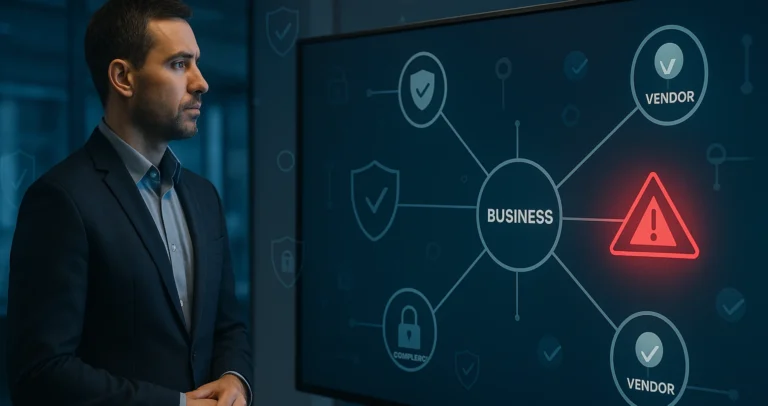Cybersecurity
Dark Web Monitoring: What Is It and Why Is It Important?
Mark Lukehart

You rely on third-party vendors for cloud services, software providers, healthcare partners, and logistics firms to keep your operations running smoothly. While these relationships streamline your business operations and expand opportunities, they also expose your organization to significant cyber threats.
Consider this: SecurityScorecard found out that 35.5% of data breaches in 2024 stemmed from third-party vendors and supply chains. The risks span data breaches, compliance failures, operational disruptions, and significant financial losses.
Implementing robust security standards and a comprehensive risk management strategy is essential. This guide provides actionable insights into third-party risk assessment and how collaborating with an external partner, such as Parachute, can help you proactively manage your cyber risk through careful metrics and ongoing vigilance.
Every third-party access to your data or systems expands your organization’s attack surface. Delegating access means you can’t directly control third-party security practices or employee behaviors, leaving you exposed to potential vulnerabilities.
Complex business ecosystems mean that a single breach in your supply chain can cascade through your operations. Hackers often exploit smaller, less secure vendors to infiltrate larger companies.
Additionally, sharing sensitive customer data, financial details, intellectual property, and operational information with third-party vendors increases vulnerability and attractiveness to hackers.
Third-party breaches can result in severe regulatory compliance fines under the General Data Protection Regulation (GDPR), the Health Insurance Portability and Accountability Act (HIPAA), and the California Consumer Privacy Act (CCPA). This leads to significant reputational damage, loss of customer trust, and extensive operational disruptions.
A compromised SaaS provider or critical vendor could halt your business operations, resulting in downtime and substantial financial losses. Trust isn’t enough. You need continuous monitoring and regular checks of your vendors.
Third-party threats come in various forms, each with unique challenges and risks. Understanding these threats thoroughly helps you to protect your business proactively.
| Threat Type | Description | Example/Impact |
|---|---|---|
| 1. Data Breaches at Vendors | Vendors are hacked or leak sensitive information, such as customer data, payment information, or intellectual property. | A marketing platform breach exposes client PII, leading to lawsuits and reputational damage. |
| 2. Supply Chain Attacks | Hackers target a vendor’s software or services to spread malware or gain broader access. | The SolarWinds attack affected thousands of organizations via a single compromised provider. |
| 3. Unsecured Integrations & APIs | Poorly protected APIs or integrations can be exploited by attackers. | An exposed API key allows unauthorized access to sensitive company systems. |
| 4. Vendor Insider Threats, and Employee Errors | Human mistakes or malicious actions from vendor staff can lead to security incidents. | A vendor employee misconfigures cloud settings, exposing customer records online. |
| 5. Sub-Contractor (Fourth-Party) Risks | Your vendors’ vendors can introduce hidden security gaps if not correctly managed. | A SaaS provider uses a low-security hosting service, which gets hacked, putting your data at risk. |
| 6. Regulatory Non-Compliance | Third-party breaches can result in severe regulatory fines under laws like HIPAA and the CCPA. Even if your business isn’t directly subject to GDPR, working with vendors who handle EU data could still create exposure. | A vendor fails to notify of a breach promptly, leading to fines under HIPAA. |
| 7. Operational Disruption | Downtime or cyberattacks at critical vendors can halt your operations. | A ransomware attack on your cloud provider can shut down operations, resulting in hours of downtime and lost revenue. |
Managing third-party risk in-house may seem manageable until you attempt to do it.
You need to vet dozens (sometimes hundreds) of vendors, continuously monitor them, manage access controls, and stay compliant with constantly evolving regulations. It’s not just time-consuming, it’s risky. Even one overlooked vendor or expired audit report could expose your business to serious consequences.
That’s where Parachute comes in.
We handle the full lifecycle of third-party threat protection, from vendor selection and contract review to real-time monitoring and incident response. Instead of running through a checklist, we operate like an extension of your team.
With Parachute, you get:
Serving as your extended shield, we provide comprehensive protection within your vendor ecosystem, ensuring that your critical operations and sensitive information remain protected, even in the face of complex external collaborations, with clarity and control.
You get less complexity. Less risk. And more time to focus on your business.
Third-party threats are no longer rare; they’re now expected. A single weak vendor can create real damage: downtime, compliance fines, or worse.
Trying to manage it all in-house means chasing audit trails, juggling tools, and reacting when it’s already too late.
Working with us at Parachute means you get a dedicated partner who handles the complexity on your behalf. From onboarding to breach response, we help you stay one step ahead, so your team can focus on growth rather than fire drills.
With Parachute’s third-party threat protection, your business stays one step ahead of cyber risks. This approach safeguards not only your sensitive information but also the future of your entire organization.
Let’s simplify your security. Contact Parachute today to start protecting your vendor ecosystem.
TPRM helps you identify, assess, and mitigate risks associated with vendors that access your data or systems. It’s key to protecting your business from avoidable security issues.
Request security certifications, such as SOC 2 or ISO 27001. Review their breach history, access policies, and incident response procedures.
Security gaps can appear at any time. Ongoing monitoring catches changes early, before they lead to a breach or compliance violation.